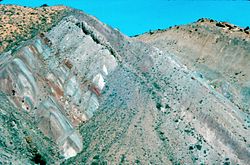| Dinosaur National Monument | |
|---|---|
IUCN category V (protected landscape/seascape) [1] | |
 A dinosaur skull embedded in rock at Dinosaur National Monument | |
| Location | Moffat County, Colorado and Uintah County, Utah, U.S. |
| Nearest city | Vernal, Utah |
| Coordinates | 40°32′N108°59′W / 40.533°N 108.983°W |
| Area | 210,844 acres (853.26 km2) |
| Established | October 4, 1915 [2] |
| Visitors | 304,468(in 2018) [3] |
| Governing body | U.S. National Park Service |
| Website | Dinosaur National Monument |


Dinosaur National Monument is an American national monument located on the southeast flank of the Uinta Mountains [4] on the border between Colorado and Utah at the confluence of the Green and Yampa rivers. Although most of the monument area is in Moffat County, Colorado, the Dinosaur Quarry is located in Utah, north of the town of Jensen, Utah. The nearest Colorado town is Dinosaur while the nearest city is Vernal, Utah.
Contents
- Geology
- History
- Fremont people
- Early scientific explorations
- National monument
- Echo Park Dam controversy
- Historic places
- Climate
- Features
- The quarry
- Fossils from Carnegie Quarry
- See also
- References
- Further reading
- External links
Originally preserved in 1915 to protect its famous Dinosaur Quarry, [5] the monument was greatly expanded in 1938 to include its wealth of natural history. The park's wild landscapes, topography, geology, paleontology, and history make it a unique resource for both science and recreation. The park contains over 800 paleontological sites and has fossils of dinosaurs including Allosaurus , Deinonychus , Abydosaurus , and various sauropods. [5] The Abydosaurus consists of a nearly complete skull, the lower jaw, and first four neck vertebrae. The specimen was found at the base of the Mussentuchit Member of the Cedar Mountain Formation and is the holotype for the species.
Paleontologist Earl Douglass of the Carnegie Museum discovered eight vertebrae of an Apatosaurus on August 17, 1909, [2] which became the first dinosaur skeleton discovered and excavated at the new Carnegie Quarry. The area around the quarry was declared a national monument on October 4, 1915. [2] The International Dark-Sky Association designated Dinosaur National Monument an International Dark Sky Park in April 2019. [6]













